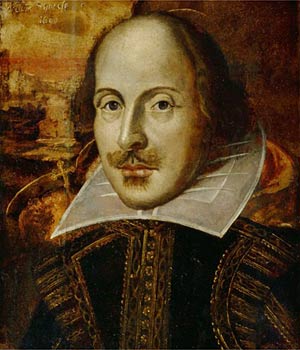1.1. Shakespeare's language
The English language in Shakespeare's time was in many ways quite different from the English we use today. In terms of the actual words used, there were several that were quite commonly used in Elizabethan-era spoken English, such as "hark" to mean "listen", or "thou art" for "you are". In speaking to each other, there were also certain formalities that were practiced between people, depending on their rank within a family or in society. In Shakespeare's writing, he often used a lot of metaphors and figurative expressions to explain things in a more colorful way instead of stating it plainly. Since most of Shakespeare's works were plays, all of the explanations take place through dialogue instead of through a narrative. He would have written in a way so that people of his time would understand colloquial expressions, phrases and references. Today it may seem a little difficult to understand at first glance, just as English speakers in the U.S., U.K. or Australia may not understand each other's slang immediately. Much of Shakespeare's work also uses various forms of prose or verse in their style. The main reason for this was to give the dialog some effect and rhythm when uttered on stage.
|
|
Most readers new to Shakespeare initially struggle with understanding the language. For most, the problems can be traced to three general causes: vocabulary, syntax, and wordplay or rhetorical devices.
Vocabulary
The Oxford English Dictionary credits Shakespeare with introducing nearly 3,000 words into the language. Besides introducing new words, Shakespeare makes use of obsolete words, like "ycleped" (called) and "wight" (man). Scholars estimate Shakespeare's vocabulary at between 25,000 and 29,000 words, nearly twice that of the average college student. The normal working vocabulary of a speaker of English is around 5,000 words.
Good readers learn to approximate meaning with some accuracy from context and from a little imaginative use of their existing vocabulary. For example, while we might not use the word "misadventure" anymore, it is not too difficult to see that this word means something like "ill chance" or "unlucky."
A special vocabulary case is Shakespeare's common use of contractions. Some readers complain about these "poetic" contractions used to create the correct number of syllables in a line. But consider this exchange overhead in the hallway (along with their possible translations):
-"Goin' to class?"
-"Already been."
-"And?"
-"Whatever."
-Are you going to class?
-I have already been to class.
-And how was it? (or And did you enjoy it? or And what happened in class? etc.)
-What business is it of yours? or It was a most enjoyable class, perhaps the best one of my academic career, etc.
Shown below are a few of the most common contractions found in Shakespeare.
'tis = it is
ope = open
o'er = over
gi' = give
ne'er = never
i'=in
e'er = ever
oft = often
a'=he
e'en = even
Syntax
Consider the following simple example, taken from Randal Robinson's Unlocking Shakespeare's Language. Take the simple sentence "I ate the sandwich." Rewrite the sentence by changing the order of the words but not the meaning of the sentence. Did you come up with six sentences?
I ate the sandwich.
I the sandwich ate.
Ate the sandwich I.
Ate I the sandwich.
The sandwich I ate.
The sandwich ate I.
In modern English, the most common sentence pattern is subject (S), verb (V), object (O), or I (S) ate (V) the sandwich (O). But as this example shows, most common does not mean only possible, and while some of these constructions ("Ate the sandwich I") are pretty unusual, they are nonetheless grammatically correct.
Unusual word order in a sentence is called inversion. Shakespeare used inversion to create specific dramatic and poetic effects. Inversion can be used to emphasize key words, to create specific poetic rhythms, to give a character a specific speech pattern (think Polonius, for example), or for a variety of other purposes.
Experienced readers "re-order" the words to understand the sentence. They locate the subject and the verb and "re-write" the sentence for clarity ("Ate the sandwich I" is quickly changed to "I ate the sandwich").
Rhetorical Devices
Puns and various other kinds of wordplay abound in Shakespeare, and much of it if rightly understood by modern audiences would scandalize those who insist on Shakespeare being taught in the schools!
Besides simple wordplay, Shakespeare makes use of many rhetorical devices, ranging from the commonplace (metaphor, simile, and so on) to the exotic (polysyndeton-the repetition of conjunctions in a series of coordinate words, phrases or clauses). It is impossible to master Early Modern rhetoric in a short time. An important step, though, is simply being aware that these texts are highly rhetorical, and the rhetoric works both to embellish the text and express characterization.
Source: http://www.calstatela.edu/faculty/jgarret/417/Reading-Shakespeare.pdf
Para saber más
Watch a sketch called "A Small Rewrite", performed by Hugh Laurie (aka House) as Shakespeare and Rowan Aktinson (aka Mr Bean) as the editor.
You can read the text here.
Objetivos
You can learn about the sonnet Shall I Compare Thee? by William Shakespeare here. Along with an audio performance of the poem, this site provides a detailed analysis of themes, imagery, and poetic devices used throughout the poem. It also paraphrases the poem and offers you some points to ponder.
